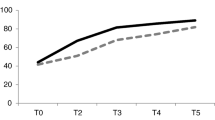Abstract
Personality characteristics in patients with long-term patellofemoral pain were compared to those of matched controls and other groups both of non-patients and of psychiatric outpatients with character disorders. Personality was described using the self-administered dependency and alexithymia scales, the Karolinska Scales of Personality and the Rorschach inkblot method. The hypothesis was that the patellofemoral pain patients would have higher levels of anxiety, depression, helplessness, aggression and alexithymic characteristics than the matched controls. There were only a few significant differences between the knee patients and the matched controls. The Rorschach measures suggested significantly greater depression, hostility and passive attitude in the knee patients as compared to the reference data. There were no indications of the hypothesised alexithymic characteristics in the knee patients. If patellofemoral pain patients do not improve as expected, referral to a pain clinic with psychological expertise could be considered.
Similar content being viewed by others
References
Acklin MW, Bernat E (1987) Depression, alexithymia, and pain prone disorder: a Rorschach study J Pers Assess 51:462–479
Ahles TA, Yunus MB, Gaulier B, Rile SD, Masi AT (1986) The use of contemporary MMPI norms in the study of chronic pain patients. Pain 24:159–163
Apfel RJ, Sifneos PE (1979) Alexithymia: concept and measurement. Psychother Psychosom 32:180–190
Bergman H, Bergman I, Engelbrektsson K, Holm L, Johanneson K, Lindberg S (1982) Psykologhandboken vid Magnus Huss-kliniken (Psychologists' handbook at the Magnus Huss Clinic). Karolinska Hospital, Stockholm
Blumer D, Heilbronn M (1982) Chronic pain as a variant of depressive disease. J Nerv Ment Dis 170:391–406
Borg G, Holmgren A, Lindblad J (1981) Quantitative evaluation of chest pain. Acta Med Scand Suppl 644:43–45
Carlsson AM (1987) Studies on pain assessment and egopsychological analysis of personality in chronic pain patients: Thesis, Karolinska Institute, Stockholm
Carlsson AM, Levander S (1993) The Rorschach method: the development from early systems for analysis and interpretation to Exner's Comprehensive System Nord J Psychiatr 47:203–208
Costello RM, Hulsey, TL, Schonfeld LS, Ramamurthy S (1987) P-A-I-N: a four cluster MMPI typology for chronic pain. Pain 30:199–209
Craig KD (1984) Emotional aspects of pain. In: Wall PD, Melzack R (eds) Textbook of pain. Churchill Livingstone. Edinburgh, pp 153–161
Ellertsen B (1992) Personality factors in recurring and chronic pain. Cephalalgia 12:129–132
Engel GL (1959) “Psychogenic” pain and the pain-prone patient. Am J Med 26:899–918
Exner JE (1986) The Rorschach: a comprehensive system, vol I: Basic foundations. Wiley, New York
Exner JE (1991) The Rorschach: a comprehensive system, vol 2: Interpretation. Wiley, New York
Fritz GK, Bleck EE, Dahl IS (1981) Functional versus organic knee pain in adolescents. Am J Sports Med 9:247–249
Leavitt F, Garron DC (1982) Rorschach and pain characteristics of patients with low back pain and “conversion V” MMPI profiles. J Pers Assess 46:18–25
Price DD (1988) Psychological and neural mechanisms of pain. Raven Press, New York
Romano JM, Turner JA (1985) Chronic pain and depression: does the evidence support a relationship? Psychol Bull 97:18–34
Rorschach H (1941) Psychodiagnostik. Methodik und Ergebnisse eines Wahrnehmungsdiagnostischen Experiment (Deutenlassen von Zufallsformen). Humber, Bern
Schalling DS, Edman G, Åsberg M (1983) Impulsive cognitive style and inability to tolerate boredom: psychobiological studies of temperamental vulnerability. In: Zuckerman M (ed) Biological bases of sensation seeking, impulsivity, and anxiety, Lawrence Erlbaum, Hillsdale, pp. 123–145
Schalling DS, Åsberg M, Edman G, Oreland L (1987) Markers for vulnerability to psychopathology: temperament traits associated with platelet MAO activity. Acta Psychol Scand 76:172–182
Sriram, TG, Chaturvedi SK, Gopinath PS, Shanmugam V (1987) Controlled study of alexithymic characteristics in patients with psychogenic pain disorder. Psychother Psychosom 47:11–17
Theorell T, Ahlberg-Hulthén G, Berggren T, Perski A, Sigala F, Svensson J, Wallin BM (1987) Arbetsmiljö, levnadsvanor och risk för hjärtsjukdom (Work environment, living habits and risk for cardiac disease). Stressforskningsrapporter nr 195, Institutet för Psykosocial Miljömedicin, Stockholm
Tunks E (1988) Behavioral interventions and their efficacy. In: Dubner R, Gebhart GF, Bond MR (eds) Proceedings of the 5th World Congress on Pain, Elsevier, Amsterdam, pp 298–309
Watkins CE (1991) What have surveys taught us about teaching and practice of psychological assessment. J Pers Assess 56:426–437
Weiner IB, Exner JE (1991) Rorschach changes in long-term and short-term psychotherapy. J Pers Assess 56:453–465
Weisenberg M (1984) Cognitive aspects of pain. In: Wall PD, Melzack R (eds) Textbook of pain Churchill Livingstone, Edinburgh, pp 162–172
Author information
Authors and Affiliations
Rights and permissions
About this article
Cite this article
Carlsson, A.M., Werner, S., Mattlar, C.E. et al. Personality in patients with long-term patellofemoral pain syndrome. Knee Surg, Sports traumatol, Arthroscopy 1, 178–183 (1993). https://doi.org/10.1007/BF01560201
Issue Date:
DOI: https://doi.org/10.1007/BF01560201



